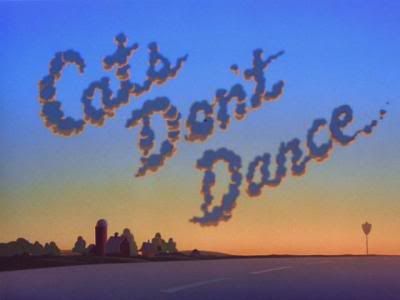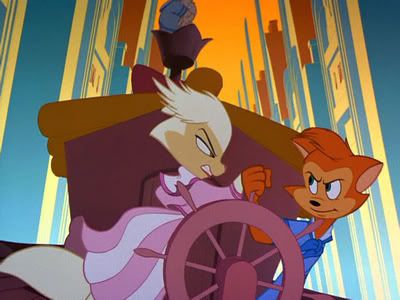02.06
You know, they don’t make them like this anymore.
I’m not just referring to animated 2D movies like Cats Don’t Dance as they are made today today. Big budget 2D animated films might be a rarity today, but back in the 90s (even the late 90s) they were still quite popular. But in that the old hacky phrase was essentially the same one used to describe the film when it originally came out in 1997.
I mean this twofold, in that as a fully 2D animated major motion picture about a cat who wants to make it in Hollywood(land) circa the 1930s era of motion pictures would have been weird even during the early 90s or late 80s, nevermind 1997 which was two years after Toy Story began to change everything. The animated landscape was changing and 2D animation was on the way out (Disney apparently thought so as well, considering how uninspired their 2D output became around that time despite a few exceptions, while Pixar began its rise) in favor of 3D CG animation. So not only did the film come out in the wrong year, and with a concept based heavily in the 1930s era to an audience who didn’t really have much knowledge (and most likely, interest) of that time period, it also was stuck inside a merger between Turner Animation -this was their only film from the division- and Warner Bros. which led to it getting no support from the studio and left to die at the box office.
Normally, this would be the end of a much weaker film. It would be as forgotten as most of Don Bluth’s excruciating 90s material or mundane pap like Quest For Camelot or The Pagemaster. But, over the years, people have begun to discover the film for what it is and have started to appreciate it’s unique approach and the ideas it has. As many are discovering, Cats Don’t Dance is a great movie that deserved more than it got. It is now no longer strange to see this film discussed among enthusiasts of animation and film, as well as kids who just simply love the film.
As I pointed out before, Cats Don’t Dance is a story about a cat named Danny who comes to Hollywood to make it big. The plot is simple and straightforward, and is merely a set up for all the ideas it wants to play with. Directed by Mark Dindal (who in turn directed one of Disney’s last 2D efforts before the revival, the similarly playful Emperor’s New Groove), the animation has personality and the art direction pops. Watching this movie, you can truly feel the love for not only the 1930s’ golden age of film, but for classic 2D animation as well. Every character is animated with such personality that you can’t help but get engaged in everything they do, and with musical numbers as good as these, you can’t help but keep your eyes glued to the screen. One particular number has the characters in desaturated colors due to their depression over not having work, but Danny lifts their spirits with a highly engaging musical number which brightens the whole area up. Every musical number is filled with ideas like this so that even those who might not like them in most movies, would be hard pressed to look away when they came on here. Outside of the musical moments, there is another fantastic scene where the characters are trapped on an ark from a film set and barreling downtown on it on top of a giant flood of water. Not only is there a lot of activity going on here, but a bunch of set pieces and jokes are blasted by during this crucial moment of the film making it true highlight.
While it is a musical, Cats Don’t Dance is not really a “Disney-style” musical. The songs are more in line with 1930s era music and are usually used as plot points instead of Disney’s approach of using their music to enhance the plot and characters. The film’s soundtrack is explosive, featuring some of the most memorable musical numbers of the decade -and considering I’m speaking of the 1990s, this is no small feat. But the music isn’t all the film has going for it, the characters are all very fun and well written in their personalities, leading to some fun chemistry between them. For all intents and purposes, this feels like the type of movie a lot of studios were trying to make to compete against Disney (including Don Bluth himself), but were never able to quite do.
If there is one criticism that can really be lobbied at the film, it is that it is 70 minutes long. Yes, children animated features are typically not much longer, but in Cats Don’t Dance’s case, the extra time could be used to improve the pacing a little. The film is a bit fast, as you would imagine, and sometimes feels like it could use a bit of breathing room from the high spirited pace of the animation, music, and plot. It all just feels a little faster than it should be, and if you aren’t paying close enough attention, you might miss something important or a really great moment in the action and not even realize it. This might not seem important, but some kids who might not have the best attention span might get lost from simply missing a minute or two and lose attention fast. It’s not a deep flaw or anything, but it might be an issue for some. Tight pacing can work great for most, but sometimes pacing that’s too great can have it’s own set of flaws as well.
Otherwise, Cats Don’t Dance has a lot of spirit, a lot of inspiration, a lot of charm, and is just a joy to watch. It might not be one of the best animated films ever if you prefer the thoughtful and pondering works of Pixar, or the more traditional and straightforward approach of Disney, but on it’s own terms few films succeed quite as well as this does in creating its unique atmosphere and style. There are few animated films (especially from the 1990s) as off the wall as this one is, while still remaining accessible to mainstream audiences. If you’re looking for something a bit different from the usual animated fare out there and with its own unique approach, you can’t really do much better than Cats Don’t Dance.
Originally posted on Monday, January 24, 2011.


